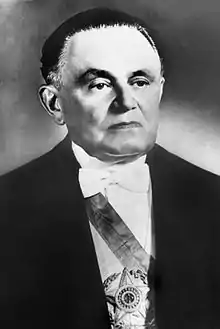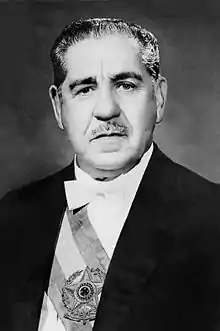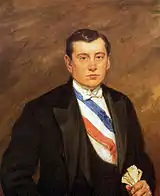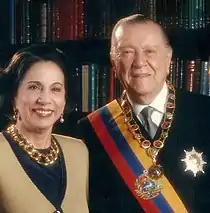Presidential sash
A presidential sash is a cloth sash worn by presidents of many nations in the world. Such sashes are worn by presidents in Africa, Asia, Europe and, most notably, in Latin America.
The sash is an important symbol of the continuity of the presidency, and is only worn by the president. Its value as a symbol of the office of the head of state can be compared to that of a crown in monarchies. When the president leaves office, he or she formally presents the sash to his or her successor as part of the official inauguration ceremony.
Presidential sashes are usually very colorful and very large and designed to resemble the nation's flag, especially those of Latin American presidents. They are usually worn over the right shoulder to the left side of the hip. The national coat of arms is also usually placed on the sash. A national order's star or chain of office can also be worn.

George Washington, who served as commander-in-chief of the Continental Army during the American Revolutionary War and later served as the first President of the United States, was noted for wearing a blue ribbed sash, similar to that of the British Order of the Garter, early in the war, as he had in 1775 prescribed the use of green, pink, and blue sashes to identify aides de camp, brigade-majors, brigadiers general, majors general, and the commander in chief in the absence of formal uniforms. He later gave up the sash as "unrepublican" and "pretentious for all but the highest-ranking aristocracy," according to historians. Washington is seen wearing the sash in Charles Wilson Peale's 1779 painting Washington at Princeton.[1][2]
Gallery
Current national leaders
 Alberto Fernández, President of the Argentine Republic, 2019–present
Alberto Fernández, President of the Argentine Republic, 2019–present.jpg.webp) Sebastián Piñera, President of the Republic of Chile, 2018–present, 2010–2014
Sebastián Piñera, President of the Republic of Chile, 2018–present, 2010–2014.jpg.webp) Lenín Moreno, President of the Republic of Ecuador, 2017–present
Lenín Moreno, President of the Republic of Ecuador, 2017–present Nayib Bukele, President of the Republic of El Salvador, 2019–present
Nayib Bukele, President of the Republic of El Salvador, 2019–present_(cropped).jpg.webp) Alejandro Giammattei, President of the Republic of Guatemala, 2020–present
Alejandro Giammattei, President of the Republic of Guatemala, 2020–present
 Mario Abdo Benítez, President of the Republic of Paraguay, 2018–present
Mario Abdo Benítez, President of the Republic of Paraguay, 2018–present

Former national leaders

.jpg.webp) Mauricio Macri, President of the Argentine Republic, 2015–2019
Mauricio Macri, President of the Argentine Republic, 2015–2019


_(1922-1926).jpg.webp)
.jpg.webp)
.jpg.webp) Getúlio Vargas, President of the Republic of the United States of Brazil, 1951–1954, 1930–1945
Getúlio Vargas, President of the Republic of the United States of Brazil, 1951–1954, 1930–1945







.tif.jpg.webp)
.jpg.webp)


.jpg.webp)
.jpg.webp)

.jpg.webp)
 Arturo Alessandri, President of Chile, 1920–1924, 1932–1938
Arturo Alessandri, President of Chile, 1920–1924, 1932–1938 Michelle Bachelet, President of the Republic of Chile, 2014–2018, 2006–2010
Michelle Bachelet, President of the Republic of Chile, 2014–2018, 2006–2010.jpg.webp) Chiang Kai-shek, President of the Republic of China, 1948–1949, 1950–1975
Chiang Kai-shek, President of the Republic of China, 1948–1949, 1950–1975 Óscar Arias, President of the Republic of Costa Rica, 2006–2010
Óscar Arias, President of the Republic of Costa Rica, 2006–2010 Danilo Medina, President of the Dominican Republic, 2012–2020
Danilo Medina, President of the Dominican Republic, 2012–2020 Rafael Correa, President of the Republic of Ecuador, 2007–2017
Rafael Correa, President of the Republic of Ecuador, 2007–2017 Gerardo Barrios, President of El Salvador, 1813–1865
Gerardo Barrios, President of El Salvador, 1813–1865_(cropped).jpg.webp) Jimmy Morales, President of the Republic of Guatemala, 2016–2020
Jimmy Morales, President of the Republic of Guatemala, 2016–2020
 Mireya Moscoso, President of the Republic of Panama, 1999–2004
Mireya Moscoso, President of the Republic of Panama, 1999–2004.jpg.webp) Fernando Lugo, President of the Republic of Paraguay, 2008–2012
Fernando Lugo, President of the Republic of Paraguay, 2008–2012 Horacio Cartes, President of the Republic of Paraguay, 2013–2018
Horacio Cartes, President of the Republic of Paraguay, 2013–2018_(cropped).jpg.webp)
.png.webp) Martín Vizcarra, President of the Republic of Peru, 2018–2020
Martín Vizcarra, President of the Republic of Peru, 2018–2020 Américo Tomás, President of Portugal, 1958–1974
Américo Tomás, President of Portugal, 1958–1974
 Desi Bouterse, President of the Republic of Suriname, 2010–2020
Desi Bouterse, President of the Republic of Suriname, 2010–2020
 Juan Vicente Gómez, President of Venezuela, 1908–1913, 1922–1929, 1931–1935
Juan Vicente Gómez, President of Venezuela, 1908–1913, 1922–1929, 1931–1935 Rafael Caldera, President of the Republic of Venezuela, 1969–1974, 1994–1999
Rafael Caldera, President of the Republic of Venezuela, 1969–1974, 1994–1999
See also
References
- Keller, Jared (November 16, 2016). "The Strange Case of George Washington's Disappearing Sash". Smithsonian. Smithsonian Institution. Retrieved September 4, 2020.
- Rogers, James (August 29, 2017). "George Washington's 'rediscovered' Revolutionary War sash on display". Fox News. 21st Century Fox. Retrieved September 4, 2020.
External links
- McCullough, J.J. "Presidential Sashes of the World". Archived from the original on 2018-11-25. Retrieved 2020-08-28.